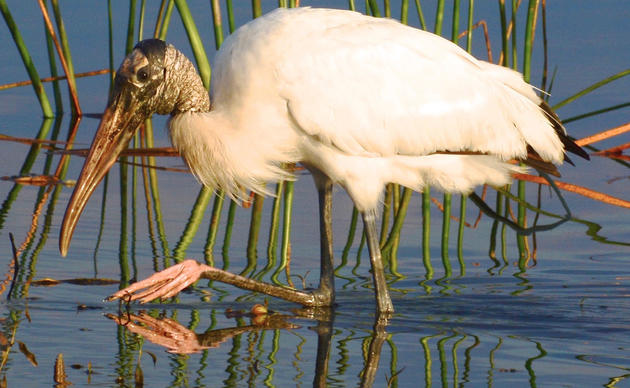Links to related stories about the discovery appear at the bottom of this article.
A year ago this month, Mac Stone and Peter Houlihan were in a treetop in Audubon’s Corkscrew Swamp Sanctuary hoping to take a history-making photograph. They got it. It just wasn’t the photo they expected.
Stone and Houlihan had hoped to take the very first photo of a giant sphinx month pollinating the rare and endangered ghost orchid – something scientists have long suspected happens but something that has never been photographed. Instead, the two National Geographic explorers got a picture of a fig sphinx moth (Pachylia ficus) doing the pollinating. And they also photographed the giant sphinx moth (Cocytius antaeus) visiting the ghost orchid (Dendrophylax lindenii) to feed but not necessarily functioning as a pollinator.
Combined, those photos turned scientific conjecture upside down.
“When I climbed up to check the trap and the image flashed on the screen, my heart nearly stopped,” Stone said. “I didn’t actually think this would work right away. It’s humbling to think that what started as a seemingly impossible idea five years ago, could actually blossom into something meaningful for science, conservation, and this ancient subtropical forest that I have come to love so much.
“Sometimes photography has the power to inspire,” Stone continued, “to take people to places they have never been, and when we’re really lucky, change our understanding of the natural world.”
Early last July, Stone and Houlihan scaled the towering bald cypress and placed a custom camera housing with an infrared motion detector in hopes of capturing the nocturnal pollination. On July 27, 2018, they realized they had their first photograph of a giant sphinx moth at a ghost orchid. In subsequent visits, they documented a fig sphinx moth pollinating the orchid.
During the same summer just east of Corkscrew, photographer Carlton Ward Jr. was undertaking a parallel effort in the Florida Panther National Wildlife Refuge. His photographs also produced evidence of various moth species visiting and pollinating ghost orchids.
“This is what science is all about, testing hypotheses about the world around us, and evolving as we learn more,” Houlihan said. “It’s now time to update the longstanding hypothesis that only the giant sphinx could pollinate the ghost. Moths with shorter tongues can function as pollinators, and may actually be more effective and reliable than the long-tongued giant sphinx. These images reveal that an entire community of hawkmoth species should be capable of pollinating ghost orchids. This is crucial information that we hope will add to the increased conservation of this iconic and endangered species in Florida.”
Stone is an Audubon partner and conservation photographer who is working on a National Geographic Society grant documenting the old growth swamps left in the United States. Houlihan is a tropical conservation scientist, National Geographic explorer, photographer, and expert on ghost orchid pollination.
“In addition to the fascinating scientific basis of this project and its findings, we saw two key things play out here,” said Shawn Clem, Research Director of Audubon Florida's Western Everglades Research Center located at Corkscrew Swamp Sanctuary. “We saw a clear demonstration of the importance of conserving and protecting Florida’s wild places and the true value of this sanctuary amidst the increasing pressure of a developed landscape. Protected natural lands like Corkscrew are critical for us to hold onto the biodiversity that makes Southwest Florida so special.
“We also saw the value of collaborations and partnerships,” Dr. Clem continued. “Globally, conservation is becoming increasingly challenging, and it will take a real team effort to make a difference for our planet’s natural resources, plants, and animals. We see our role as a living laboratory for discoveries like this one as an important part of our mission.”
Corkscrew Swamp Sanctuary’s “Super” Ghost Orchid was famous even before these historic photographs. Since its discovery in 2007 by visitors searching for owls, the ghost orchid has attracted thousands of visitors worldwide. This orchid is unique among ghost orchids as it is the largest and most prolific flowering ghost orchid known to exist, once producing more than 40 flowers in a season. It also grows higher than any other and had the earliest known flowering, producing blooms in January in 2015.
“In 1954 Audubon established the Corkscrew Swamp Sanctuary to save an old-growth cypress forest from exploitation,” said Sanctuary Director Lisa Korte. “This protection allows us to continue to make new discoveries today, 65 years later. Every day brings new experiences at Corkscrew, where naturalists and scientists are encouraged to explore and contribute to our understanding of the natural world.”
The “Super” Ghost Orchid is currently in bloom. Because it is 100 feet off the boardwalk and 50 to 60 feet up in an ancient bald cypress tree, it is difficult to see with the naked eye or even photograph with a standard lens. Corkscrew has positioned a spotting scope on the boardwalk for the public to view the flowers. Visitors are encouraged to bring binoculars or a camera with a powerful lens. Corkscrew rents binocular for $3.
The Sanctuary is open daily every day of the year from 7 a.m. until 5:30 p.m. with the last admission at 4:30 p.m.




